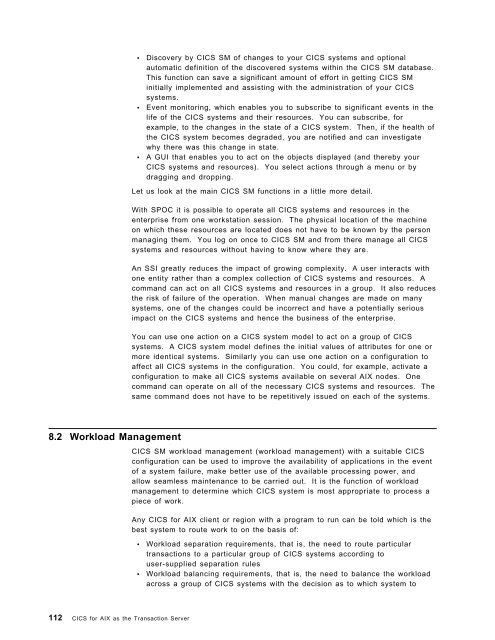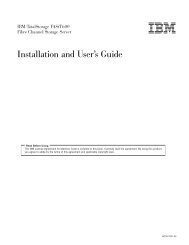Addressing OLTP Solutions with CICS: The Transaction Server ... - Ibm
Addressing OLTP Solutions with CICS: The Transaction Server ... - Ibm
Addressing OLTP Solutions with CICS: The Transaction Server ... - Ibm
You also want an ePaper? Increase the reach of your titles
YUMPU automatically turns print PDFs into web optimized ePapers that Google loves.
8.2 Workload Management<br />
112 <strong>CICS</strong> for AIX as the <strong>Transaction</strong> <strong>Server</strong><br />
• Discovery by <strong>CICS</strong> SM of changes to your <strong>CICS</strong> systems and optional<br />
automatic definition of the discovered systems <strong>with</strong>in the <strong>CICS</strong> SM database.<br />
This function can save a significant amount of effort in getting <strong>CICS</strong> SM<br />
initially implemented and assisting <strong>with</strong> the administration of your <strong>CICS</strong><br />
systems.<br />
• Event monitoring, which enables you to subscribe to significant events in the<br />
life of the <strong>CICS</strong> systems and their resources. You can subscribe, for<br />
example, to the changes in the state of a <strong>CICS</strong> system. <strong>The</strong>n, if the health of<br />
the <strong>CICS</strong> system becomes degraded, you are notified and can investigate<br />
why there was this change in state.<br />
• A GUI that enables you to act on the objects displayed (and thereby your<br />
<strong>CICS</strong> systems and resources). You select actions through a menu or by<br />
dragging and dropping.<br />
Let us look at the main <strong>CICS</strong> SM functions in a little more detail.<br />
With SPOC it is possible to operate all <strong>CICS</strong> systems and resources in the<br />
enterprise from one workstation session. <strong>The</strong> physical location of the machine<br />
on which these resources are located does not have to be known by the person<br />
managing them. You log on once to <strong>CICS</strong> SM and from there manage all <strong>CICS</strong><br />
systems and resources <strong>with</strong>out having to know where they are.<br />
An SSI greatly reduces the impact of growing complexity. A user interacts <strong>with</strong><br />
one entity rather than a complex collection of <strong>CICS</strong> systems and resources. A<br />
command can act on all <strong>CICS</strong> systems and resources in a group. It also reduces<br />
the risk of failure of the operation. When manual changes are made on many<br />
systems, one of the changes could be incorrect and have a potentially serious<br />
impact on the <strong>CICS</strong> systems and hence the business of the enterprise.<br />
You can use one action on a <strong>CICS</strong> system model to act on a group of <strong>CICS</strong><br />
systems. A <strong>CICS</strong> system model defines the initial values of attributes for one or<br />
more identical systems. Similarly you can use one action on a configuration to<br />
affect all <strong>CICS</strong> systems in the configuration. You could, for example, activate a<br />
configuration to make all <strong>CICS</strong> systems available on several AIX nodes. One<br />
command can operate on all of the necessary <strong>CICS</strong> systems and resources. <strong>The</strong><br />
same command does not have to be repetitively issued on each of the systems.<br />
<strong>CICS</strong> SM workload management (workload management) <strong>with</strong> a suitable <strong>CICS</strong><br />
configuration can be used to improve the availability of applications in the event<br />
of a system failure, make better use of the available processing power, and<br />
allow seamless maintenance to be carried out. It is the function of workload<br />
management to determine which <strong>CICS</strong> system is most appropriate to process a<br />
piece of work.<br />
Any <strong>CICS</strong> for AIX client or region <strong>with</strong> a program to run can be told which is the<br />
best system to route work to on the basis of:<br />
• Workload separation requirements, that is, the need to route particular<br />
transactions to a particular group of <strong>CICS</strong> systems according to<br />
user-supplied separation rules<br />
• Workload balancing requirements, that is, the need to balance the workload<br />
across a group of <strong>CICS</strong> systems <strong>with</strong> the decision as to which system to
















